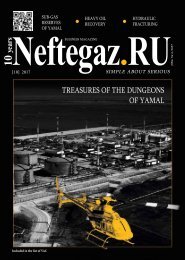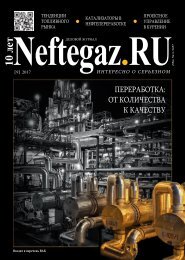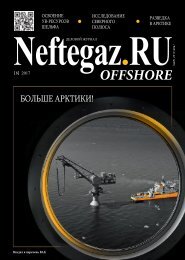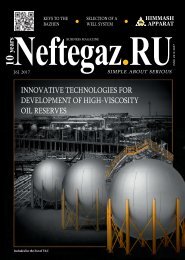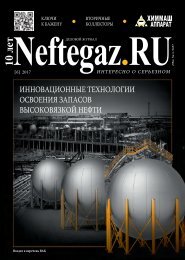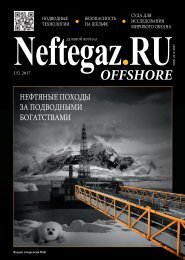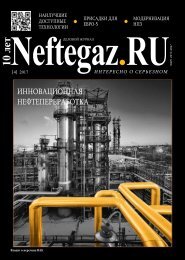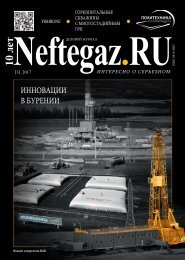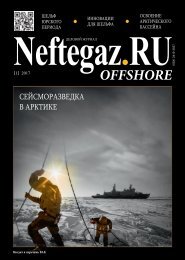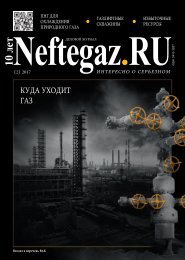Neftegaz.RU #3-17 ENG
Create successful ePaper yourself
Turn your PDF publications into a flip-book with our unique Google optimized e-Paper software.
OFS<br />
conveyed fluid corrosive properties.<br />
Therefore, during the downhole<br />
drilling motor operation it is<br />
necessary to pay special attention<br />
to the selection of appropriate drill<br />
mud. The elastomer as technical<br />
material should have a low gas<br />
impermeability and water tightness,<br />
as well as chemical resistance.<br />
However, most elastomers are<br />
able to absorb gas and lightly<br />
corrosive fluids. The following are<br />
typical changes the elastomers are<br />
subjected to: swelling, shrinkage,<br />
solidification, softening [2, 4, 5].<br />
Furthermore, the bottomhole<br />
temperature is a limiting factor for<br />
engine operation. Series-production<br />
domestic engines are designed<br />
for long-term operation at the<br />
bottomhole temperature up to<br />
100°С. At the rise in temperature<br />
in IRP-1226 rubber (used in most<br />
domestic engines) irreversible<br />
changes of mechanical properties<br />
occur leading to faster wear<br />
of the stator elastomer insert,<br />
performance deterioration and<br />
premature failure of the down hole<br />
motor power section.<br />
As a result, it was decided to carry<br />
out the experimental researches<br />
on evaluation of stability of<br />
IRP-1226 rubber specimens at<br />
engine temperature rise under the<br />
influence of different mediums.<br />
During this experiment the<br />
process of drill-string running<br />
was simulated; running speed<br />
was assumed to be 1.5 m/s.<br />
The following parameters were<br />
determined as the design basis:<br />
total vertical depth – 2,670 m,<br />
geothermal gradient – 3°С/100<br />
m, drillpipe stand length – 30<br />
m (deemed time for making<br />
a connection – 4 min). The<br />
following items were calculated<br />
in accordance with the initial<br />
parameters: experiment duration –<br />
384 min, engine end temperature<br />
– 80°С.<br />
Simulation of drill-string running<br />
and consequently the rise of drill<br />
mud temperature were carried out<br />
in a desiccator. Test specimens<br />
were made in the shape of cylinder<br />
with diameter up to 43 mm and<br />
thickness up to 11.5 mm. They<br />
were kept in plastic containers<br />
with total immersion into the<br />
liquid medium. Processing the<br />
experiment results, the changes<br />
of the specimen weight and its<br />
diameter at the temperature rise in<br />
the liquid medium were assessed.<br />
Initial measurement of input<br />
parameters was made at the<br />
temperature of 25°С; further<br />
measurements were made after<br />
every 5°C rise in temperature,<br />
simulating then the drill-string<br />
running for 165 m (23.5 min of the<br />
experiment). Reaching the depth of<br />
1,680 m, the specimen parameters<br />
were measured after every 10°С<br />
rise in temperature, simulating then<br />
the drill-string running for 330 m<br />
(50 min of the experiment).<br />
Processing and analyzing the<br />
obtained data, the following<br />
correlations were exposed. After<br />
completion of the experiment, the<br />
weight reduction was observed for<br />
all specimens. Nevertheless, in the<br />
temperature range of 25 to 50°С<br />
most specimens had no expressed<br />
tendency towards weight variation;<br />
its random variation was observed.<br />
The exceptions were the specimens<br />
immersed in the salt brine;<br />
these specimens demonstrated<br />
the tendency towards the<br />
weight reduction throughout<br />
the experiment. The specimens<br />
immersed in solution based on<br />
diesel fuel, oil and multigrade lowtemperature<br />
hydraulic oil (see Table<br />
1) were subjected to maximum<br />
relative weight variation. The weight<br />
reduction can be attributed to the<br />
washing-out of rubber plasticizer<br />
from IRP-1226 specimens.<br />
For all specimens, it was recorded<br />
the growth in diameter as the<br />
temperature became closer to<br />
80°С. The temperature range of 25<br />
to 40 – 50°С has no clear tendency<br />
towards an increase or reduction<br />
in size of the specimens which is<br />
illustrative of the potential danger<br />
for elastomer. The maximum<br />
relative diameter change was<br />
demonstrated by the specimens<br />
immersed in multigrade lowtemperature<br />
hydraulic oil, salt brine<br />
and oil. The specimens placed in<br />
the alkaline solution (see Table 1)<br />
were subjected to the minimum<br />
relative diameter change.<br />
Thus, the whole temperature<br />
interval studied for the analyzed<br />
dispersing mediums may have<br />
a negative impact on the DDM<br />
stator. Uncontrolled variation of<br />
engine performance can occur<br />
within the range of 25 – 50°С<br />
due to the change of gap width<br />
and consequently the tightness<br />
FIG. 1. Dependence of IRP-1226 specimen diameter change from temperature in the presence<br />
of different dispersing mediums<br />
[3] <strong>Neftegaz</strong>.<strong>RU</strong> ~ 35



